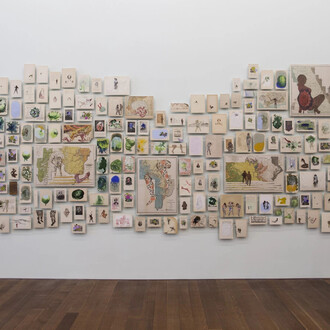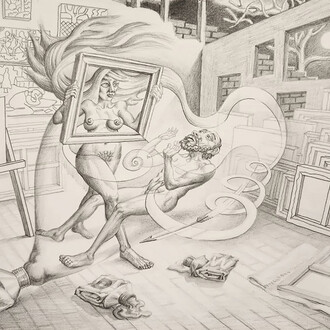The Museum of Contemporary Art (MCA) Chicago features its in-depth collection of the work of Alexander Calder (American, 1898–1976), examining how the artist developed over the course of his influential fifty-year career. MCA DNA: Alexander Calder presents the artist’s mobiles, stabiles, and works on paper spanning the years 1927 to 1974. The exhibition is curated by Michael Darling, MCA James W. Alsdorf Chief Curator, and is on view October 12, 2013– August 17, 2014.
The group of works in this exhibition explores Calder’s interest in form, balance, color, and movement. Calder combined colorful shapes abstracted from nature-most notably animal 2 forms-with an interest in engineering and mechanics to create dynamic, hanging “mobiles” that move with air currents and form ever-changing compositions. Calder is also known for his “stabiles” that evoke movement but do not move, instead encouraging a different kind of visitor experience. Calder’s works resonate in today’s art world, where viewer-interaction is increasingly acknowledged in artistic exchanges.
The exhibition explores how Calder often used found materials in his studio. A shortage of sheet metal- Calder’s preferred industrial material-during World War II led him to use salvaged and recycled materials in works such as Little Face (1943), featuring eyes fashioned from broken wine glasses and lips from pieces of a broken taillight. Calder’s use of discarded materials was also a result of his ongoing interest in experimenting with forms, as can be seen in Bird (1952), made from beer cans, coffee cans, and wire. Also on display is a work from a little known group of bronze works first cast in 1944. In these pieces, Calder further explores his interest in balance by working with the weightiness of this metal.
The city of Chicago has played an important role to the development of Calder’s career. In 1974, as part of the inaugural ceremonies for Calder’s public art piece-he monumental Flamingo (1973) located on Federal Plaza in Chicago’s Loop-Mayor Richard J. Daley declared a “Calder Day” and a circus-themed parade transported the artist down State Street. As part of these festivities, MCA Chicago mounted a major exhibition of Calder’s works, and his art has since had a steady presence in the MCA galleries. In 2010 the MCA Chicago presented a major traveling exhibition Alexander Calder and Contemporary Art: Form, Balance, Joy. This exhibition explored Calder’s influence on the new generation of contemporary sculptors with the presentation of sixty of Calder's iconic works mounted along with sculptures by seven contemporary artists who list Calder as an influence.
The core of this collection comes from the Ruth and Leonard Horwich Family Loan, which the MCA has housed, cared for, and displayed since 1995. The Horwich Family remains a preeminent collector of Surrealist and Chicago Imagist art, and as some of the earliest supporters and founders of the MCA, helped to build the MCA collection in these same areas. The Horwichs became friends with Calder and traveled to France to visit him, ultimately acquiring more than two-dozen major Calder artworks.
















